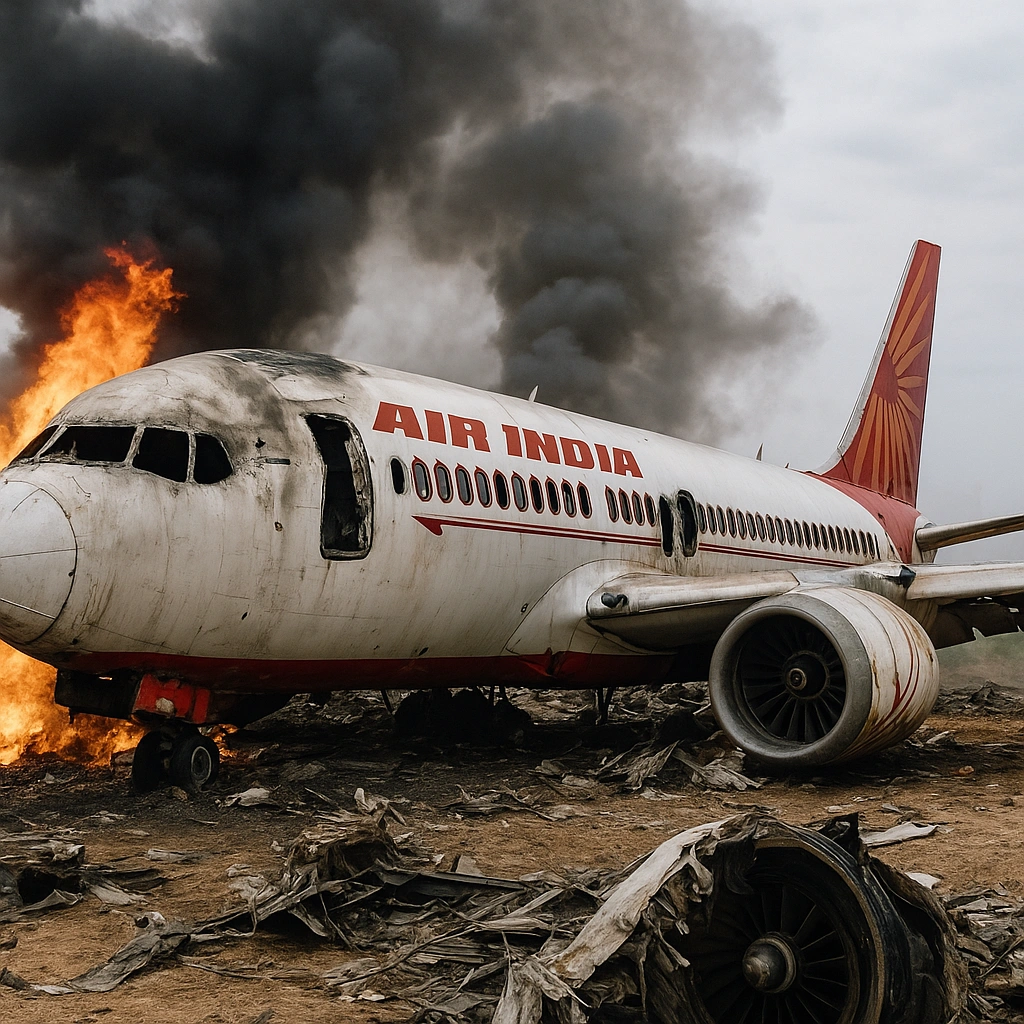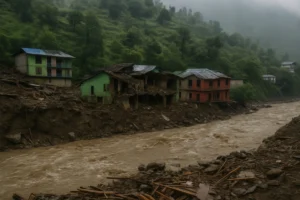What Went So Horribly Wrong? Inside the Air India Crash in Ahmedabad That Shook a Nation

Scene showing the destroyed Air India aircraft after the tragic crash in Ahmedabad.
The Air India crash in Ahmedabad has emerged as one of the most devastating aviation tragedies in recent Indian history. With over 200 lives lost and a nation in mourning, the incident has raised urgent questions about flight safety, emergency response, and accountability. As investigations unfold, the crash near Ahmedabad stands as a grim reminder of the risks that continue to shadow commercial aviation in India.
Table of Contents
1. A Morning Flight That Never Arrived
Ahmedabad, India — July 7.
It began like any other flight. Families waved from glass barriers, engines roared to life, and Flight AI-171 lifted from Sardar Vallabhbhai Patel International Airport, heading toward London. But within moments, the normalcy shattered. The jet — a Boeing Dreamliner — dropped from the sky just minutes into its journey. The Air India crash in Ahmedabad marked the country’s most fatal aviation incident in half a decade.
By sunrise, black smoke covered the skies above Hansol, a quiet suburb now transformed into a disaster zone. Local farmers and commuters were first on the scene — not emergency services. “I saw fire fall from the sky,” said Mukesh Bhatt, a nearby resident. “The sound… it wasn’t just loud. It was final.”
2. The Toll No One Imagined
At least 211 lives were lost, according to local authorities — among them children, students, professionals, and elders. Nine passengers survived, pulled out from twisted wreckage, barely clinging to life. Doctors at Civil Hospital reported burns, fractures, and trauma — both visible and not.
One of the survivors, a 26-year-old student en route to begin a master’s degree in London, was found unconscious, pinned between mangled seats and the crushed wall of the fuselage. “She hasn’t spoken since,” a nurse whispered. “Only opens her eyes when she hears her mother’s voice.”
For dozens of families, the airport waiting lounge turned into a place of despair. Some cried, some sat in silence. Others simply refused to believe what they’d heard on the news.
3. How Did the Crash Happen?
The Air India crash in Ahmedabad is still under investigation. Both black boxes were recovered by the National Disaster Response Force and handed over to the Directorate General of Civil Aviation (DGCA). Early speculation hints at a catastrophic engine failure, possibly within the first five minutes after takeoff — but officials remain cautious.
Air traffic recordings captured the final, incomplete communication from the cockpit: “We have a… (unintelligible)…” followed by static.
Nearby CCTV footage and eyewitnesses confirm one engine trailing fire before the plane banked sharply to the left. Seconds later, impact.
4. Questions Begin to Mount
How could this happen to one of India’s flagship aircraft? The Dreamliner was believed to be in excellent condition, part of Air India’s upgraded fleet since its acquisition by Tata Group. According to a recent audit, the aircraft had passed its last safety check barely 12 days ago.
Yet the crash raises old concerns:
- Are safety protocols on paper being followed in practice?
- Are airline crews being overworked?
- Is India’s rapid aviation growth outpacing its regulatory checks?
Captain Rehman Khan, a retired pilot with over 30 years of experience, was blunt: “This is not about one crash. It’s about a culture of complacency.”
5. Leadership Responds, But Public Trust Wavers
Prime Minister Narendra Modi called the incident a “profound tragedy” and vowed full-scale investigations. Air India, visibly shaken, issued a statement promising support to victims’ families and immediate suspension of similar aircraft for inspection.
But for the public, especially frequent flyers, confidence has taken a sharp hit.
“Should I get on that plane next week?” asked Aarti Sharma, a tech worker from Pune booked on the same route. “Or should I cancel and live another day?”
International media has picked up the story. British news outlets confirmed 27 UK nationals were onboard. The British High Commission has sent diplomats to Ahmedabad, coordinating with Indian officials.
Also go through Why Monsoon Viral Fever in India Keeps Coming Back—And What We’re Still Not Doing About It
6. Who Were the Passengers? Lives Interrupted Mid-Flight
Among the passengers was a family of five on their way to reunite with their daughter in Birmingham. A PhD scholar who had just secured funding to present her work in Cambridge. Two elderly tourists taking their first trip abroad. Their names now appear in obituaries and condolence banners.
A tragedy like the Air India crash in Ahmedabad is more than a headline — it’s hundreds of stories, all ending at once.
7. What Happens Next?
The Ministry of Civil Aviation has grounded all Dreamliners operating on similar long-haul routes until a technical audit is complete. Global aviation bodies, including the International Civil Aviation Organization (ICAO), have requested updates from Indian regulators.
Air India has announced a ₹10 crore emergency fund to assist grieving families. But the conversation around safety is only beginning.
Analysts now warn that India’s air traffic, which has doubled in the last five years, may be outgrowing its safety infrastructure. Aviation is booming, but has the system matured enough to handle the stakes?
8. A City Mourns, A Country Watches
Back at the crash site, debris remains scattered. Flowers have begun to appear on the edge of the police cordon. Children from nearby villages place garlands and small flags next to the scorched field.
As the nation mourns the Air India crash in Ahmedabad, the demand for accountability grows louder. Behind every photograph shown on the news, behind every name read aloud, lies a story — interrupted not by time, but by tragedy.
You can also visit Ahmedabad plane crash.






